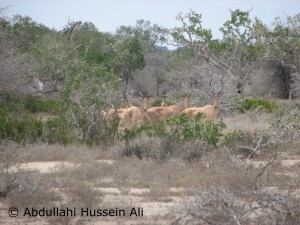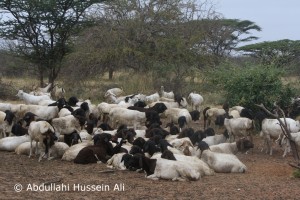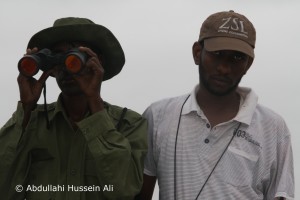My name is Abdullahi Hussein Ali and I have just started as an EDGE Fellow working on the globally endangered hirola antelope (Beatragus hunteri). This unique antelope is restricted to the Kenya-Somalia border and is one of the most endangered mammals in Africa. The aims of my proposed work as an EDGE Fellow will be conducted through my PhD dissertation research at the University of Wyoming. My work is focusing on hirola population dynamics, habitat use, and the effects of land-use change in northeastern Kenya for hirola. This information will be used to guide management strategies through the Hirola Management Committee of the Kenya Wildlife Service. All of my work involves capacity building and education of local communities within the Ijara and Fafi Districts in north-eastern Kenya.
 Although hirola have never been common, they have dwindled in number from roughly 10,000 in 1970 to somewhere around 300-500 today. The reasons for this decline (and equally the reasons preventing contemporary recovery) are mysterious; formal research in this geographic area has been logistically difficult given political unrest and tribalism. However, we suspect that a combination of habitat loss; competition with livestock; predation; disease; and drought are the major threats facing this species, although the roles of each in driving hirola declines remain unclear.
Although hirola have never been common, they have dwindled in number from roughly 10,000 in 1970 to somewhere around 300-500 today. The reasons for this decline (and equally the reasons preventing contemporary recovery) are mysterious; formal research in this geographic area has been logistically difficult given political unrest and tribalism. However, we suspect that a combination of habitat loss; competition with livestock; predation; disease; and drought are the major threats facing this species, although the roles of each in driving hirola declines remain unclear.
In 2010, working with a team representing the Hirola Management Committee, the Kenya Wildlife Service, and the Northern Rangelands Trust, I initiated research to understand why hirola have declined, and what might be done to prevent the species from going extinct. The first phase of my findings will be published in the 2012.

I am grateful to have the support of the Zoological Society of London. I look forward to updating you regularly on the progress and the findings of our work in the coming years. Thank you!
